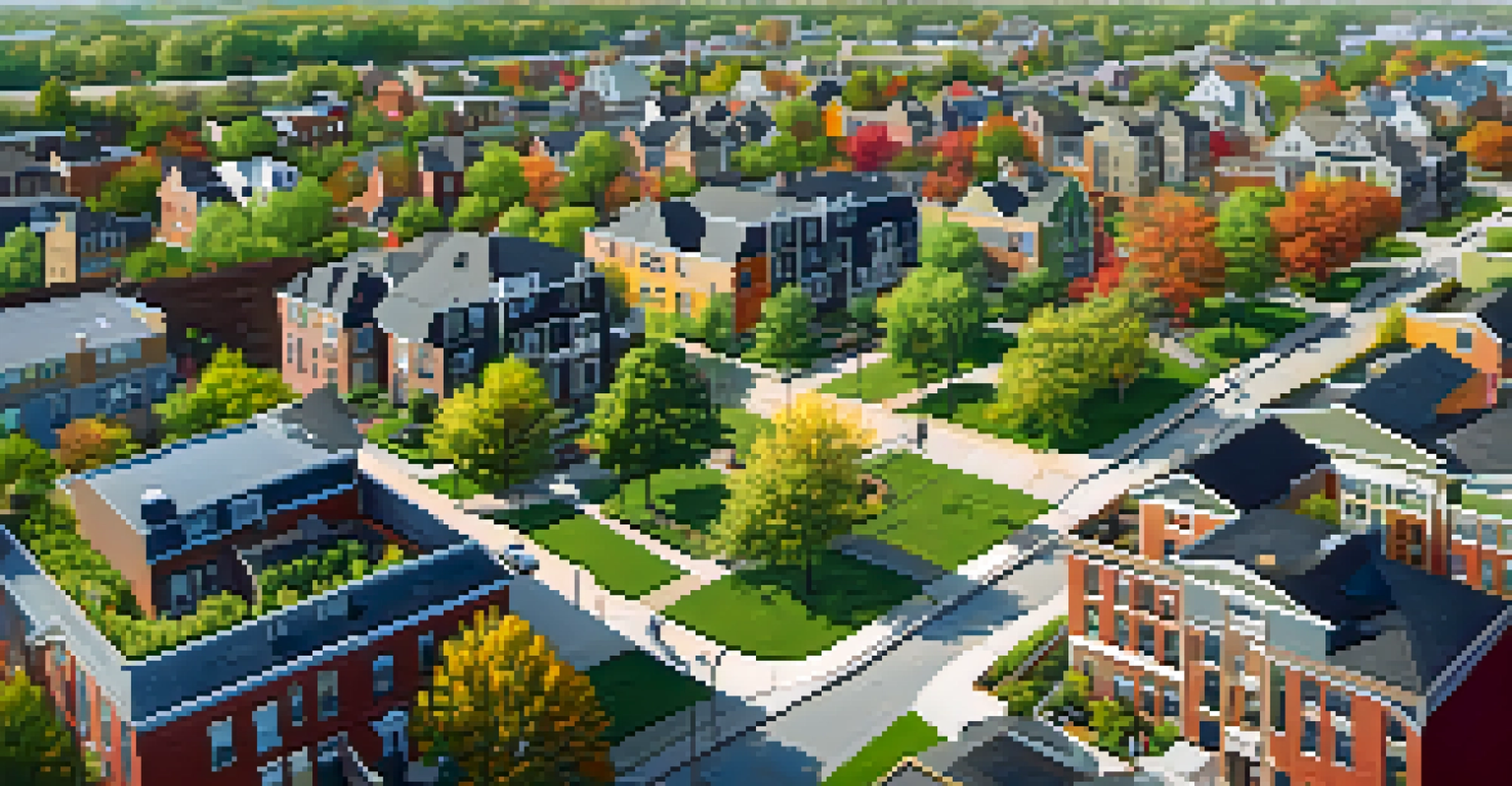The Decline and Revival of Buffalo: A City Resilient

The Historical Context of Buffalo's Decline
Buffalo, once a booming industrial hub, faced significant decline in the late 20th century. The city's economy heavily relied on manufacturing jobs, which began to dwindle as factories closed and businesses relocated. This shift not only led to job losses but also resulted in a population exodus, leaving behind abandoned buildings and a struggling economy.
The greatest glory in living lies not in never falling, but in rising every time we fall.
As the steel and grain industries faltered, Buffalo's vibrant neighborhoods began to suffer. With fewer jobs available, many residents sought opportunities elsewhere, leading to a stark demographic shift. The once-bustling downtown became a shadow of its former self, with empty storefronts and a declining tax base, creating a challenging environment for those who remained.
Despite these challenges, the spirit of Buffalo's residents endured. Community organizations and grassroots movements emerged, striving to revitalize the city and restore its former glory. This resilience would lay the groundwork for the revival that was on the horizon.
Key Factors in Buffalo's Revival
Buffalo's revival can be attributed to several key factors, including significant investments in infrastructure and urban development. Initiatives such as the Buffalo Billion program aimed to stimulate the local economy by encouraging new businesses and attracting talent. This influx of investment helped transform neglected areas into thriving commercial and residential spaces.

Additionally, Buffalo's rich cultural scene played a vital role in its resurgence. The city boasts a wealth of art, music, and culinary experiences that draw both locals and tourists alike. Events like the Buffalo Niagara Film Festival and the resurgence of local breweries have fostered a sense of community and pride among residents, making the city an attractive destination.
Buffalo's Economic Shift
Buffalo has transitioned from a manufacturing-based economy to a diversified one, emphasizing technology, healthcare, and education.
Finally, the collaboration between public and private sectors has been crucial in driving Buffalo's growth. Partnerships with educational institutions, like the University at Buffalo, have resulted in innovation hubs and research initiatives that provide valuable job training and attract new industries. This synergy has helped create a more diversified economy, paving the way for a sustainable future.
The Role of Community Engagement
Community engagement has been a cornerstone of Buffalo's revival, with residents taking an active role in shaping their neighborhoods. Local organizations have spearheaded initiatives to beautify public spaces, host events, and foster a sense of belonging. This grassroots involvement has not only enhanced the city's aesthetics but also strengthened community ties.
Community is much more than belonging to something; it’s about doing something together that makes belonging matter.
One notable example is the Buffalo Common Council's efforts to involve citizens in decision-making processes. By hosting town hall meetings and encouraging feedback, residents have been empowered to voice their concerns and ideas. This inclusive approach has led to more responsive governance, ensuring that revitalization efforts align with the needs and desires of the community.
Moreover, the rise of local businesses has further fueled community engagement. Entrepreneurs are not just creating jobs but are also investing in the neighborhoods they serve. This commitment to the local economy has fostered a sense of loyalty among residents, contributing to a vibrant, interconnected community.
Revitalization of Historic Architecture
Buffalo is renowned for its stunning architecture, with numerous historic buildings that reflect its rich past. The revival efforts have included the restoration of these architectural gems, breathing new life into the city's skyline. Projects like the renovation of the Statler City and the restoration of the Electric Tower have become symbols of Buffalo's commitment to preserving its heritage.
These revitalization projects not only enhance the aesthetic appeal of the city but also serve practical purposes. Historic buildings have been repurposed for modern use, such as converting warehouses into loft apartments and office spaces. This blend of old and new creates a unique atmosphere that attracts residents and visitors alike, contributing to the city's character.
Community Engagement Drives Change
Active community involvement has been essential in revitalizing Buffalo, fostering a sense of belonging and enhancing local governance.
Additionally, the preservation of architecture has sparked interest in Buffalo's history, prompting educational initiatives and tourism. Guided tours and exhibitions showcase the city's architectural legacy, fostering a deeper appreciation for its cultural significance. Through these efforts, Buffalo is not only honoring its past but also shaping its future.
Buffalo's Economic Transformation
Buffalo's economic landscape has transformed dramatically, moving from a reliance on manufacturing to a more diversified economy. Sectors like technology, healthcare, and education have gained prominence, providing new job opportunities for residents. This shift has made the city more resilient against economic downturns, as it no longer depends solely on one industry.
The tech sector, in particular, has seen explosive growth, with startups and established companies setting up shop in Buffalo. This influx of innovation has attracted young professionals and entrepreneurs, eager to be part of the city's revitalization. Initiatives like the 43North business competition have further fueled this growth, offering funding and support to promising startups.
Moreover, Buffalo's strategic location along the U.S.-Canada border has opened up new economic avenues. The city has become a hub for cross-border trade and logistics, leveraging its transportation infrastructure to facilitate commerce. This advantage not only boosts the local economy but also positions Buffalo as a key player in the regional market.
Cultural Renaissance in Buffalo
Buffalo's cultural renaissance is evident in its vibrant arts scene, which has flourished alongside the city's revitalization. The establishment of art galleries, theaters, and music venues has created a thriving cultural landscape that attracts artists and performers. Events like the Buffalo Arts Festival celebrate local talent and foster a sense of community pride.
Food culture has also experienced a resurgence, with a wave of new restaurants and cafes highlighting Buffalo's culinary diversity. From iconic Buffalo wings to innovative farm-to-table concepts, the city's dining scene has something for everyone. This culinary renaissance not only delights locals but also draws food enthusiasts from afar, contributing to Buffalo's reputation as a foodie destination.
Cultural Renaissance Thrives
The city's cultural scene has flourished, showcasing a vibrant arts community and diverse culinary offerings that attract residents and tourists alike.
Furthermore, the city is embracing its cultural diversity, celebrating the traditions and contributions of various communities. Festivals celebrating different heritages enrich the city's cultural fabric, fostering inclusivity and understanding. This celebration of diversity has become a hallmark of Buffalo's identity, making it a welcoming place for all.
Looking Ahead: Buffalo's Future
As Buffalo continues to evolve, its future looks promising, fueled by the resilience of its citizens. Ongoing projects aim to further enhance infrastructure, improve public transportation, and create green spaces, all contributing to a higher quality of life. These developments are designed to attract new residents and businesses, ensuring the city's growth continues.
Moreover, the emphasis on sustainability is becoming increasingly important in Buffalo's planning efforts. Initiatives focused on renewable energy, waste reduction, and urban farming are gaining traction, reflecting a commitment to environmental stewardship. By prioritizing sustainable practices, Buffalo is not only enhancing its livability but also setting an example for other cities.

Ultimately, the story of Buffalo is one of resilience, transformation, and hope. With a strong sense of community, a rich cultural heritage, and a commitment to innovation, the city is poised to thrive in the years to come. As Buffalo continues to rise, it stands as a testament to the power of perseverance and the potential for renewal.